This resource offers training for community based organizations and workers in the aftermath of natural disasters. It includes educational materials as well as trainer guides and tools.
Blog post from the U.S. Department of Labor highlighting common hazards during hurricane cleanup as well as links to additional readings.
Information on keeping food and water safe for consumption and best hygiene practices in the face of disasters.
Offers tips about potential hazards and protective strategies during disaster cleanup.
California's Medical Supervision Program is a biomonitoring program that measures cholinesterase activity in bloog samples from agricultural workers. Employers are required by law to contract with physicians who have registered for this program, all of whom are included in this list.
Safety and Health Practicesfor Nail Salon Workers and a Training Guide for Nail Salon Worker Safety and Health Outreach Program
- Best_Practices_HOPE.pdf (230 KB)
- Trainer_Guide_HOPE.pdf (1.34 MB)
Resources in English and Spanish from Florida State University's Center for Child Stress and Health on how to talk to a child about deportation and associated stress.
- CCSH_Deportation_EN.pdf (72.55 KB)
- CCSH_Deportation_SP.pdf (70.94 KB)
Available in English and Spanish!
Created by MCN, medical student Rachel Kelley of UCSF, and collaborators at East Tennessee State University, this guide is intended to be a reference for health care providers who work with people employed in the U.S. tomato industry. It aims to prepare providers with a more detailed understanding of hazards, health issues, and work processes associated with different tomato industry jobs.
This guide draws on published research, experienced health professionals’ advice, and information gathered from interviews and focus groups conducted with 36 tomato workers from diverse backgrounds and 14 community leaders familiar with tomato workers’ health in multiple states. It is important to note that health and safety conditions at any particular farm or company may vary from what is described here. Furthermore, individual workers may experience the same set of conditions differently.
The first section of the guide focuses on health hazards and health conditions commonly encountered in tomato production. The second section consists of detailed descriptions and illustrations of different tomato production tasks. The third section covers “human resources” information and policies that apply to U.S. agricultural workers generally. The appendices contain a Spanish-English glossary, further detail about different types of pesticides, information about agricultural occupational health policies and regulation, and a list of resources and readings.
A kit from the CDC designed to help reduce the risk of infection by the Zika virus. "If you live in a state or area with the mosquito that spreads the Zika virus and are concerned about Zika, build your own Zika Prevention Kit (...). Reducing the risk for Zika is particularly important for pregnant women."
Information from the CDC on the Zika Virus and pregnant women.
Zika educatinal materials from the Texas Department of State Health Services which includes fact sheets, push cards, posters, and TV PSAs. Available in both English and Spanish.
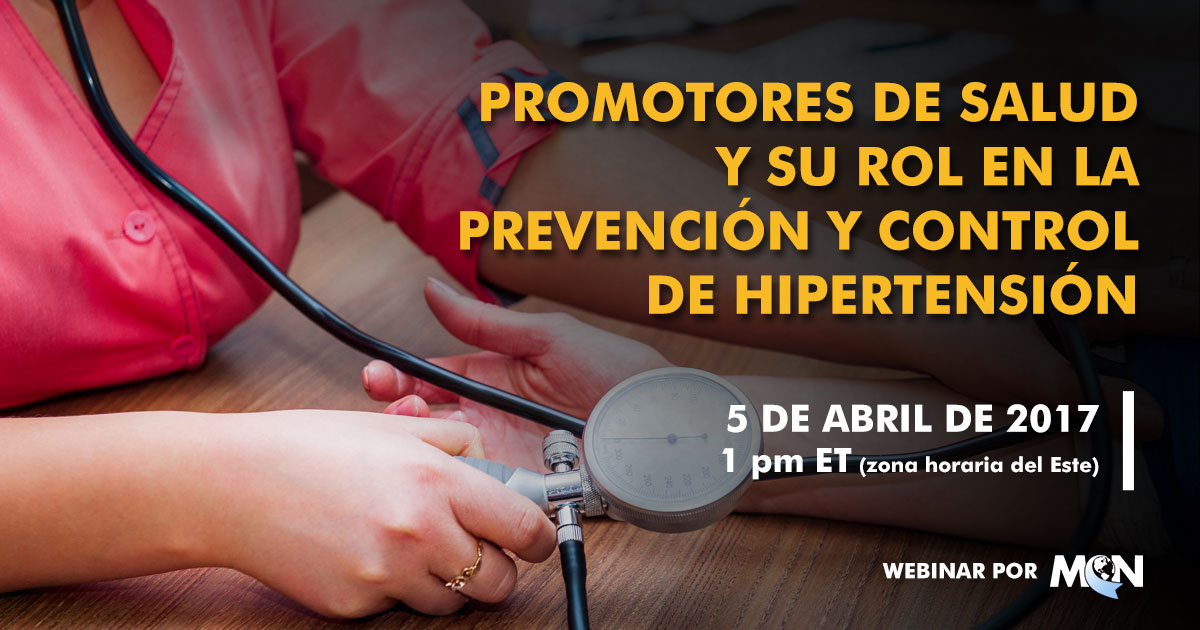
FECHA DE GRABACION: 5 de Abril de 2017, 1 pm ET (zona horaria del Este)
ORADORA: Ileana Ponce-González, MD, MPH, CNC
Crédito de educación continua
Para recibir credito de Trabajador/a de Salud Comunitaria o Educacion de Continua de Enfermera después de ver alguno de estos seminarios usted debe hacer lo siguiente:
- Completar la evaluación participante asociado a cada webinar
- Enviar un correo electrónico con su nombre y apellido indicando que ha completado a contedu@migrantclinician.org
Descripción
En este webinar, los participantes podrán identificar las medidas de desempeño de la Administración de Servicios de Recursos de Salud relacionadas con la hipertensión, describir cómo medir la hipertensión en el cuerpo, entender cómo alentar a los pacientes a controlar y manejar su presión arterial alta y entender las principales barreras que enfrentan pacientes en el control y manejo de su presión arterial alta.
Objetivos de aprendizaje
- Identificar los síntomas y signos de presiones sanguíneas altas
- Describir cómo se puede medir la hipertensión en el cuerpo
- Alentar a los pacientes a controlar y manejar su presión arterial alta
- Comprender las principales barreras que enfrentan los pacientes en el control de su presión arterial alta
Lectura Adicional
- HRSA: Hypertension Controls
- NIH: Help Your Heart: Control Your High Blood Pressure - Handouts
- NIH: Description of High Blood Pressure
- NIH: How Is High Blood Pressure Treated?
- NIH: Impediments to and potential strategies for effective blood pressure control
- USPSTF, AAFP Finalize Hypertension Screening Recommendations for Adults
- WSDF: Improving the Screening, Prevention, and Management of Hypertension
Este proyecto cuenta con el apoyo de la Administración de Recursos y Servicios de Salud (HRSA) del Departamento de Salud y Servicios Humanos de los Estados Unidos bajo el acuerdo de cooperación número U30CS09742, Asistencia Técnica a Centros de Salud Comunitarios y Migrantes y Personas sin Hogar por $ 1,094,709.00 con 0% del total Proyecto NCA financiado con fuentes no federales. Esta información o contenido y las conclusiones son las del autor y no deben ser interpretadas como la posición o política oficial de, ni cualquier endosos deben ser inferidos por HRSA, HHS o el Gobierno de los Estados Unidos.
- http://migrantclinician.adobeconnect.com/p71v9ojksgg/?OWASP_CSRFTOKEN=19499ccb24fdb83af0f6a5e559d20d4f5fffa5406927c78fbb67676b38141c94
- http://www.hrsa.gov/quality/toolbox/measures/hypertension/
- https://www.nhlbi.nih.gov/health-pro/resources/heart/hispanic-health-manual/session-4#handouts
- https://www.nhlbi.nih.gov/health/health-topics/topics/hbp
- https://www.nhlbi.nih.gov/health/health-topics/topics/hbp/treatment
- https://www.ncbi.nlm.nih.gov/pmc/articles/PMC1993926/table/tbl1/
- http://www.aafp.org/news/health-of-the-public/20151015htnprevrec.html
- https://www.healthit.gov/sites/default/files/13_bptoolkit_e13l.pdf
Una guía para saber cómo reaccionar cuando vea que acosan a alguien. La ilustración artística y el guión son de Uriel Saenz y Alma Galván
Chapter 14: Pesticides Are Poison from the Hesperian.org health guide: A Community Guide to Environmental Health.
Includes EPA manual "How to Comply With the 2015 Revised Worker Protection Standard For Agricultural Pesticides - What Owners and Employers Need To Know" and an excerpt specifically for clininicians regarding medical evaluation and respirator fit test. See also the medical evaluation questions in English and Spanish.
A flier created by the CDC's National Diabetes Education Program as a guide for patients in the management of medicines to treat diabetes. Available in English.
- Diabetes and You - All Medicines Matter.pdf (442.21 KB)
Diabetes HealthSense provides easy access to resources to help you live well and meet your goals—whether you have diabetes or are at risk for the disease. Available in English.
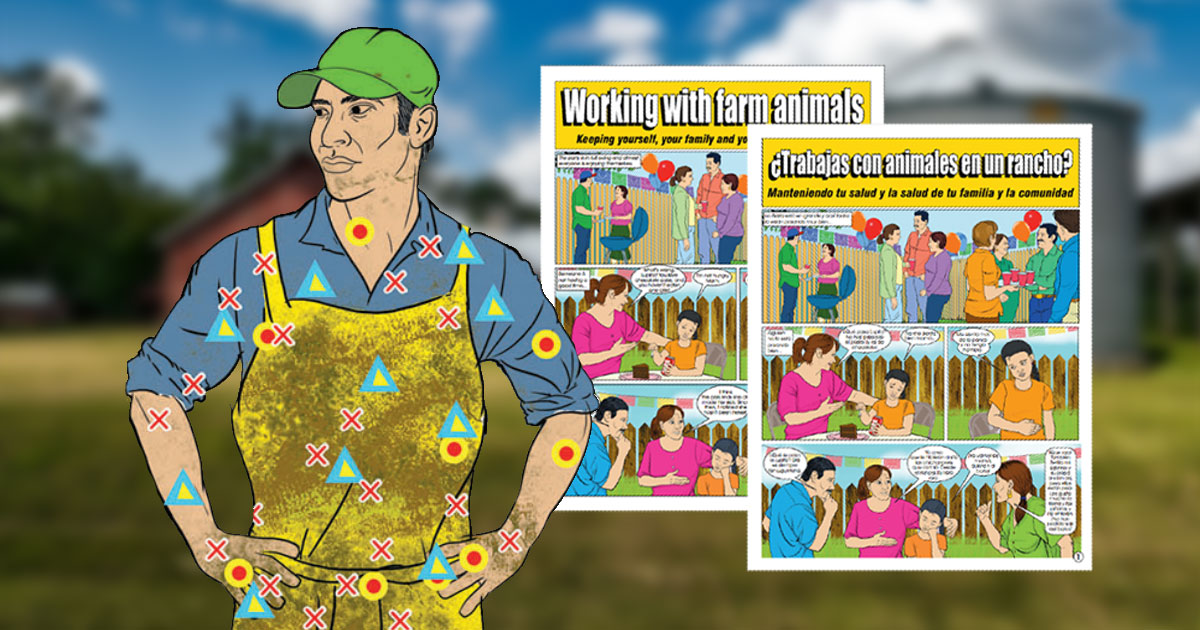
Libro cómic educativo bilingüe sobre cómo prevenir las enfermedades zoonóticas. Desarrollado por MCN en colaboración con la Universidad Estatal de Ohio.
- Working with farm animals_1.pdf (13.33 MB)
- Trabajos con animales en un rancho_1.pdf (13.31 MB)
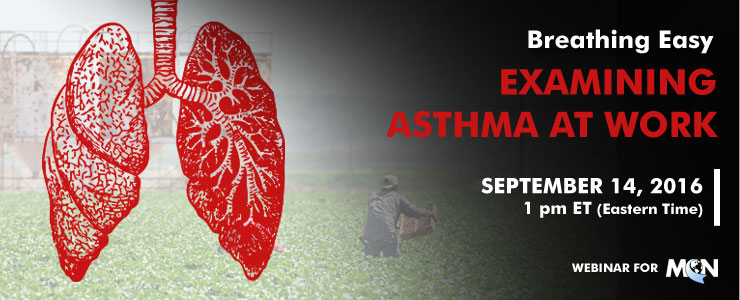
DATE RECORDED: September 14, 2016 at 1 pm ET
PRESENTED BY: Robert Harrison, M.D., M.P.H.
- Recorded Webinar
- Participant Evaluation
- Presentation Slides (PDF)
This material will be produced under grant number SH-27640-15-60-F-48-SH5 from the Occupational Safety and Health Administration, U.S. Department of Labor. It will not necessarily reflect the views or policies of the U.S. Department of Labor, nor does mention of trade names, commercial products, or organizations imply endorsement by the U.S. Government.

DATE RECORDED: September 14, 2016 at 1 pm ET
PRESENTED BY: Robert Harrison, M.D., M.P.H.
This material will be produced under grant number SH-27640-15-60-F-48-SH5 from the Occupational Safety and Health Administration, U.S. Department of Labor. It will not necessarily reflect the views or policies of the U.S. Department of Labor, nor does mention of trade names, commercial products, or organizations imply endorsement by the U.S. Government.
- https://youtu.be/MpNJ-qxL1O0
- http://www.migrantclinician.org/
- https://www.osha.gov/Publications/OSHA3707.pdf
- https://www.thoracic.org/statements/resources/eold/an-official-ats-statement-work-exacerbated-asthma.pdf
- http://journal.publications.chestnet.org/article.aspx?articleid=1044851
- http://www.nj.gov/health/eoh/survweb/wra/documents/asthmagens.pdf
- http://www.ccohs.ca/oshanswers/diseases/asthma.html
- http://www.aoec.org
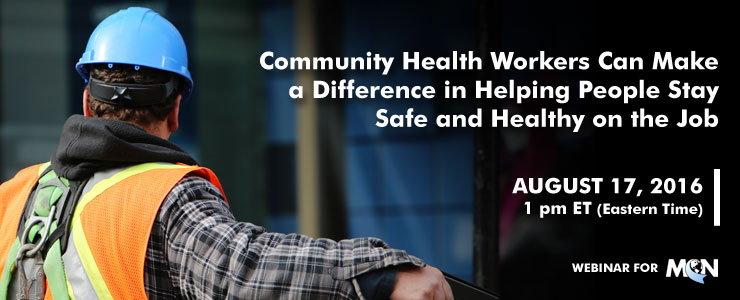
DATE RECORDED: August 17, 2016 at 1 pm ET
PRESENTED BY: Amy Liebman, MPA, MA and Wilson Augustave, member of MCN’s Board of Directors and Senior HIV Case Manager at Finger Lakes Community Health
This material will be produced under grant number SH-27640-15-60-F-48-SH5 from the Occupational Safety and Health Administration, U.S. Department of Labor. It will not necessarily reflect the views or policies of the U.S. Department of Labor, nor does mention of trade names, commercial products, or organizations imply endorsement by the U.S. Government.
- http://migrantclinician.adobeconnect.com/p50hmpih2ti/?OWASP_CSRFTOKEN=3e2b187aeeb1282a41d5df37d8a98c307a7e00006662aca9d5f21dc12aa036c4
- http://www.migrantclinician.org/
- http://workerscomphub.org/
- http://workerscomphub.org/navigating-system
- https://www.osha.gov/workers/index.html
- http://www.coshnetwork.org/know-your-rights
- http://hesperian.org/books-and-resources/

MCN y Farmworker Justice ofrecen estas guías para ayudar a los médicos en la comprensión de regulaciones de salud y seguridad de los campesinos. Información de los Estándares de Saneamiento de la Administración de Seguridad y Salud Ocupacional (OSHA) para los campos; la Ley Federal de Insecticidas, Fungicidas y Rodenticidas (FIFRA) regulado por la Agencia de Protección Ambiental (EPA); la Ley de la Protección de la Calidad de los Alimentos (FQPA) también regulado por el EPA; y el estándar de protección del trabajador (WPS) establecido por el EPA.
- OSHA's Field Sanitation Standard Clinician's Guide.pdf (747.53 KB)
- FIFRA FQPA Clinician's Guide.pdf (287.9 KB)
- WPS Clinician's Guide.pdf (843.35 KB)

MCN y Farmworker Justice ofrecen estas guías para ayudar a los médicos en la comprensión de regulaciones de salud y seguridad de los campesinos. Información de los Estándares de Saneamiento de la Administración de Seguridad y Salud Ocupacional (OSHA) para los campos; la Ley Federal de Insecticidas, Fungicidas y Rodenticidas (FIFRA) regulado por la Agencia de Protección Ambiental (EPA); la Ley de la Protección de la Calidad de los Alimentos (FQPA) también regulado por el EPA; y el estándar de protección del trabajador (WPS) establecido por el EPA.
- OSHA's Field Sanitation Standard Clinician's Guide.pdf (747.53 KB)
- FIFRA FQPA Clinician's Guide.pdf (287.9 KB)
- WPS Clinician's Guide.pdf (843.35 KB)

MCN y Farmworker Justice ofrecen estas guías para ayudar a los médicos en la comprensión de regulaciones de salud y seguridad de los campesinos. Información de los Estándares de Saneamiento de la Administración de Seguridad y Salud Ocupacional (OSHA) para los campos; la Ley Federal de Insecticidas, Fungicidas y Rodenticidas (FIFRA) regulado por la Agencia de Protección Ambiental (EPA); la Ley de la Protección de la Calidad de los Alimentos (FQPA) también regulado por el EPA; y el estándar de protección del trabajador (WPS) establecido por el EPA.
- OSHA's Field Sanitation Standard Clinician's Guide.pdf (747.53 KB)
- FIFRA FQPA Clinician's Guide.pdf (287.9 KB)
- WPS Clinician's Guide.pdf (843.35 KB)

DATE RECORDED: June 22, 2016
PRESENTED BY: Kerry Brennan
This material will be produced under grant number SH-27640-15-60-F-48-SH5 from the Occupational Safety and Health Administration, U.S. Department of Labor. It will not necessarily reflect the views or policies of the U.S. Department of Labor, nor does mention of trade names, commercial products, or organizations imply endorsement by the U.S. Government.
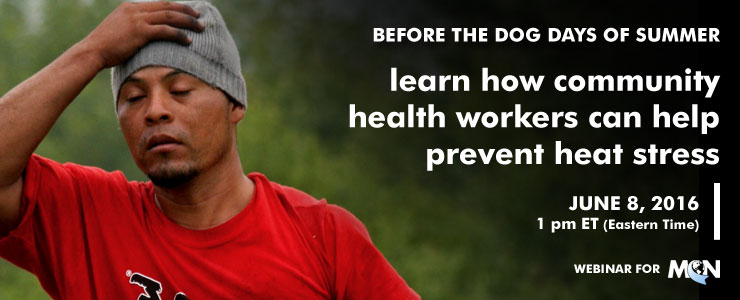
DATE RECORDED: June 8, 2016
PRESENTED BY: Juliana Simmons, MSPH, CHES
This material will be produced under grant number SH-27640-15-60-F-48-SH5 from the Occupational Safety and Health Administration, U.S. Department of Labor. It will not necessarily reflect the views or policies of the U.S. Department of Labor, nor does mention of trade names, commercial products, or organizations imply endorsement by the U.S. Government.
- https://youtu.be/qcCci3GQs04
- http://www.migrantclinician.org/
- https://www.osha.gov/SLTC/heatstress/prevention.html
- http://www.farmworkerjustice.org/sites/default/files/FJpesticidetrainingspanish2016.pdf
- https://www.osha.gov/SLTC/heatstress/index.html
- https://www.osha.gov/SLTC/heatillness/index.html
- https://www.osha.gov/SLTC/heatstress/industry_resources.html
- http://www.dir.ca.gov/dosh/heatIllnessQA.html
- http://www.lni.wa.gov/Safety/Topics/AtoZ/HeatStress/
- http://en.hesperian.org/hhg/Workers%27_Guide_to_Health_and_Safety:Dangers_from_heat
- http://www.naplesnews.com/news/crime/report-farmworkers-death-should-have-been-prevented-2738c212-4e00-109c-e053-0100007fd972-363310521.html
- http://www.cdc.gov/niosh/topics/heatstress/heatrelillness.html
